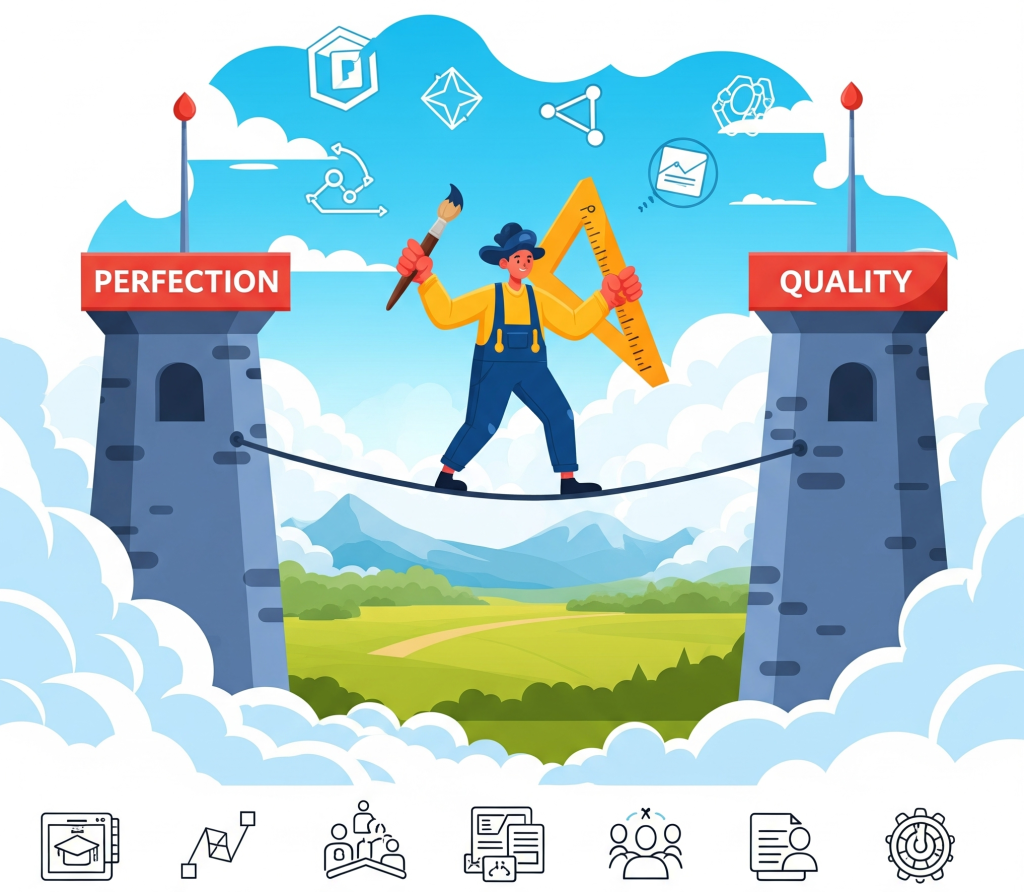We’ve all been there: another round of feedback, a set of minuscule changes, the deadline looming… In learning (design industry), the pursuit of perfection often becomes a double-edged sword. While “perfect is the enemy of good” might sound cliché, it’s a mantra worth remembering. How do I know that? I was guilty of this same sin.
Remember, the goal is to create effective learning that delivers real results. Sometimes, that means launching a module that’s at 90% rather than endlessly pursuing that elusive 100%.
The hidden costs of perfectionism
Let’s talk about the elephant in the room: over-testing.
How many times have you found yourself in an endless cycle of reviews, where each stakeholder adds their layer of scrutiny? What started as a straightforward module becomes bogged down in multiple rounds of testing, each applying increasingly strict criteria that weren’t part of the original scope.
Consider this scenario:
Your team has developed a compliance training module. The content is solid, the interactions are engaging, and the learning objectives are met. Yet, the project is three weeks behind schedule because:
- Legal wants another review of every screen
- The compliance team has new scenarios to add
- The brand team needs all colours to be exactly 2% darker
- Someone spotted a full stop that should be a semicolon
Sound familiar?
Striking the Right Balance
1. Define “Good Enough” Early
Work with stakeholders to establish clear acceptance criteria at the project’s outset. Document:
- Essential compliance requirements
- Minimum technical specifications
- Core learning outcomes
- Acceptable quality thresholds
2. Implement a Staged Review Process
Rather than waiting for everything to be perfect:
- Conduct early prototype reviews
- Use rapid development cycles
- Get stakeholder sign-off on content before visual design
- Lock down feedback stages with clear deadlines
3. Focus on Learning Impact
Ask yourself:
- Will this change significantly improve learning outcomes?
- Is this feedback addressing a genuine learning need?
- Could this time be better spent on other aspects of the project?
Ask the team:
- Are we testing the right things?
- Does this feedback cycle add value?
- What’s the cost of delay vs. the benefit of changes?
- How will learners benefit from these revisions?
4. Adopt Agile Principles
Even in traditional waterfall environments, you can:
- Release minimum viable modules
- Gather learner feedback early
- Plan for post-launch improvements
- Track and measure actual usage patterns
5. Build Quality into the Process
Instead of endless testing:
- Create robust design templates
- Develop style guides and standards
- Use automated quality checks where possible
- Implement peer review systems

For Learning Designers
Set Clear Boundaries
- Establish feedback deadlines
- Limit review rounds
- Document scope changes
- Communicate the impact on timelines (Do it!)
Prioritise Feedback
- Critical (affects learning outcomes or compliance), e.g. accuracy
- Important (impacts user experience)
- Nice-to-have (aesthetic preferences)
Document Trade-offs. When pushing back on perfectionism, highlight:
- Budget implications
- Timeline impacts
- Opportunity costs
- Learner benefits
Focus on Continuous Improvement
- Plan for version updates
- Track user feedback
- Monitor completion rates
- Measure actual performance impact
Quality in learning design is about impact.
By establishing clear standards, implementing efficient processes, and maintaining focus on learner outcomes, we can create high-quality solutions without falling into the perfectionism trap.
The next time you find yourself in the endless review cycle, remember: sometimes good enough is better than perfect, especially when “perfect” means missing deadlines, exceeding budgets, or losing sight of what matters: helping people learn effectively.
